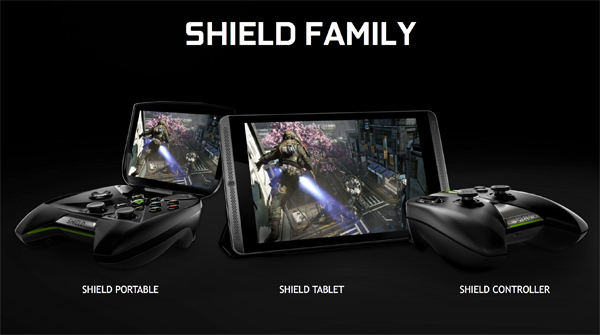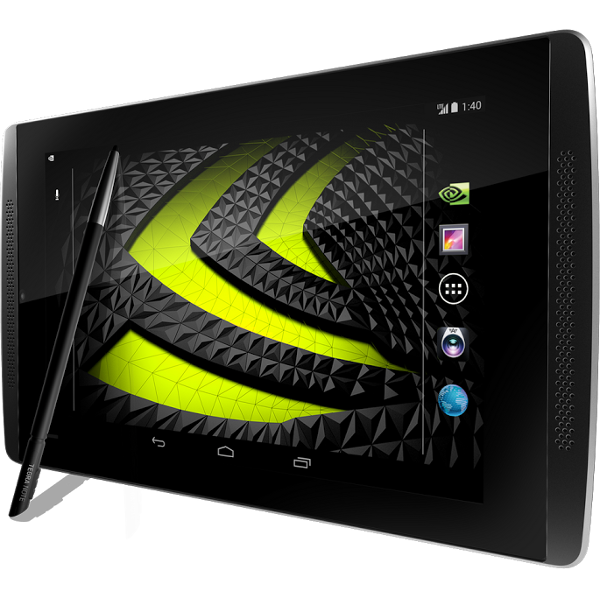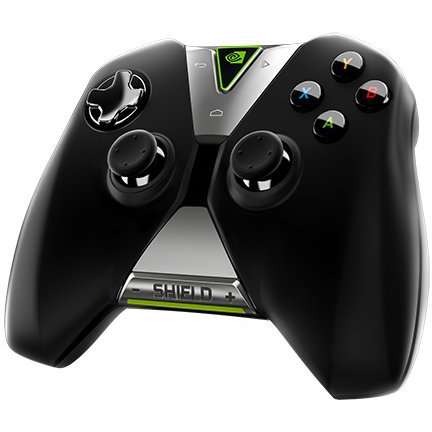Nvidia Officially Unveils the Shield Tablet and Shield Controller
The Shield Tablet advances both mobile media consumption and gaming by combining the best features of the Tegra Note 7 and Shield handheld gaming device into a compelling mini tablet and wireless controller.
The Nvidia Shield Tablet And Controller Create A Compelling Package
With desktop PC sales in a slump and consumers increasingly embracing mobile form factors and the cloud, Nvidia's focus is understandably shifting to mobile gaming. In 2013, Nvidia released two consumer products for mobile: the Tegra Note 7 tablet and the Shield, a handheld gaming device with an integrated 5-inch 720p screen and powered by a Tegra 4 SoC. Any doubt regarding Nvidia's commitment to this low power, fast moving market was quelled during CES 2014 when Nvidia announced that all future GPUs would be mobile-first designs.
The goals for Tegra Note 7 and the Shield were promoting the Tegra 4 SoC and pushing Android as a gaming platform. Over the past year, Nvidia has also gleaned valuable feedback and knowledge from these initial products, and greatly expanded the catalog of Shield compatible games by a factor of three. With a foothold firmly established in the mobile ecosystem, Nvidia is now ready to launch the next evolution in mobile gaming.
The new Shield Tablet improves upon the Tegra Note 7 in several ways, and when combined with the all new wireless Shield Controller, provides the same rich gaming experience as the Shield (now called Shield Portable).
Technical Specifications
The hardware inside the Shield Tablet receives significant upgrades, including Nvidia’s new Tegra K1 SoC. While the Tegra K1 still uses four ARM Cortex-A15 CPUs tuned for high performance and one -A15 companion core that’s optimized for low power just like the Tegra 4 found in the Tegra Note 7, Tegra K1 moves to a 28 nm HPM process and updates the -A15 cores from revision two to revision three. These enhancements boost max CPU clock frequency to 2.2 GHz, a 20% improvement over the Tegra Note 7.
The bump in CPU performance is welcome, but the real gem inside the Tegra K1 is the GPU. Gone is the GeForce ULP from previous Nvidia SoCs, a design that was consistently outgunned by other high-end GPUs. Replacing it is a component derived from the PC Kepler architecture. While this mobile variant of Kepler is understandably scaled down from the desktop version (Tegra K1 contains a single SMX with 192 CUDA cores), it’s still the same architecture and maintains full software compatibility. For more information about the new GPU and Tegra K1, be sure to read our Nvidia Tegra K1 In-Depth article.
We haven’t had a chance to benchmark the Tegra K1 ourselves yet, but if Nvidia’s benchmark results are accurate, we can expect roughly a 3x increase in GPU performance compared to the Adreno 330 in the Samsung Tab Pro 8.4 and the PowerVR G6430 in the iPad Air. This is a huge jump in performance that will easily make Tegra K1 the fastest mobile GPU, faster even than Qualcomm’s latest Adreno 420 in Snapdragon 805. In fact, Nvidia claims that Tegra K1’s performance is similar to the Xbox 360 and PS3 consoles.
The Kepler architecture brings more than just raw performance to the Shield Tablet and mobile in general, it also supports the modern desktop/console graphics APIs, including OpenGL 4.4 and DirectX12. Why is this important? With the same hardware architecture and software API support, along with the performance increase, it means console and PC games can be ported more easily. The Shield Tablet, along with other devices using the Tegra K1, gains access to the extensive game catalogs from the Xbox 360 and PS3. In addition to the potential influx of older console titles, current generation games, with some modification, could also run on the Shield Tablet. With future titles, we could see versions released simultaneously that could run natively on mobile devices. In short, it appears that Tegra K1 and the Shield Tablet may finally usher in a new era in mobile gaming; not one dominated by Flappy Bird clones, but the one we were all hoping for when Nvidia first entered the mobile market.
Get Tom's Hardware's best news and in-depth reviews, straight to your inbox.
This was the clear message from Google I/O 2014 where Tegra K1 was running an impressive looking Unreal Engine 4 demo, complete with volumetric fog, advanced lighting, and smoke effects. Part of what makes this possible is support for the Android Extension Pack (AEP), which is a set of graphics API extensions to OpenGL ES 3.1 that help bridge the feature gap with DirectX11.
Pricing And Availability
The Shield Tablet comes in two different configurations: a Wi-Fi only version with 16 GB of internal storage for $299 and a version that comes with LTE and 32 GB of internal storage for $399. The wireless Shield Controller is available separately for $59. There’s also a Shield Cover that protects the screen and functions as a stand for $39.
This is the first consumer product that Nvidia is launching worldwide (the Shield Portable and Tegra Note 7 were available in the U.S. only). The Shield Tablet and accessories will be available July 29 in the U.S. and Canada, with pre-orders starting July 22. The launch date for Europe is August 14 and will be launching in additional regions in fall 2014.
The LTE version will be unlocked and support penta-band LTE (700, 850, 1700, 1900, 2600 MHz) and quad-band UMTS/WCDMA (850, 1700, 1900, 2100 MHz) in North America, which limits it to AT&T and T-Mobile in the U.S. Outside North America it supports four LTE bands (800, 1800, 2100, 2600 MHz) and four UMTS/WCDMA bands (850, 900, 1900, 2100 MHz).
Current page: The Nvidia Shield Tablet And Controller Create A Compelling Package
Next Page Design and Features-
TechyInAZ Cool! What a great tablet for not just gaming, but it can also be a great productivity powerhouse.Reply -
DarkSable ... seriously Tom's?Reply
Websites have been proclaiming the end of the world as we know it (or at least of desktop computers) for years now, and it's all just built on itself. The reason desktop sales have declined marginally is because most home users already have a desktop fast enough for their needs, and only need to replace it when it breaks.
The other reason is that people have leapt headfirst into the pile of hype that surrounds tablets, which means they're going to see great growth... right until they hit market saturation. -
InvalidError Reply
Tablet sales have already started to slow down; probably in large part due to tablet specs having remained mostly stagnant for much of the past two years. I hoped the N7-2013 would start a flood of decent ~$200 devices but it seems most of the sub-$300 segment just continued filling up with devices having specs closer to the N7-2012 instead.13776476 said:The other reason is that people have leapt headfirst into the pile of hype that surrounds tablets, which means they're going to see great growth... right until they hit market saturation.
PCs on the other hand are getting bumper sales on the back of companies being forced off XP. -
hahmed330 I have to correct one thing Matt... You can use Nvidia Grid Streaming from anywhere, but obviously you need latency of less then 40ms and 10mbit download speed for a great experience. I am seriously looking forward for the whole review though. Direct Stylus 2 looks really interesting. Hopefully Remote Gamestream has come out of beta.Reply -
TheMentalist People always open their mouth saying the shield is worthless. It's the best hardware you get for the money!Reply -
DarkSable Guys, read what I was saying.Reply
Never did I say that the Shield, or the shield tablet, was worthless - I think they're great pieces of tech.
I was annoyed with Tom's Hardware for perpetuating the absolutely faulty myth, which has been around for at least five years now, that desktop computers are "on their way out" and that we should all give up and buy mobile devices.
I have a 3ds and a nexus 5, both of which I like to game on... but that doesn't mean I'm giving up my gaming computer, or that gaming computers aren't going to exist in a few years. -
kamhagh That Price is amazing!!!! Also i agree with darkdable,,Reply
Phones will NEVER replace pc, well at least not for next 80 years! And touch is the worst kind of input, specially for gaming, but its portable and good! Ita good to play awesome games outside and bring it with you, but still, its not pc!!! Pc is amazing, mouse and keyboard, huge screen, -
InvalidError Reply
Well, Intel is putting more effort in their laptop/mobile/embedded R&D and still pushing power-efficiency across the board, Nvidia adopted a mobile-first design mentality, AMD is moving to a heavily if not exclusively APU-centric device lineup, etc.13777299 said:I was annoyed with Tom's Hardware for perpetuating the absolutely faulty myth, which has been around for at least five years now, that desktop computers are "on their way out" and that we should all give up and buy mobile devices.
They might not be dropping desktops overnight but they are all moving in the same general direction: towards a future of mostly low-power if not mobile/embedded systems.
XP maintaining a ~30% market share until Microsoft dropped public support for it is living proof that many people and applications do not need anywhere near as much processing power as today's entry-level systems provide. Intel's Q2 report says ASPs have dropped by 3%, meaning that a fair chunk of Intel's end-of-XP bumper sales are for lower-end/lower-cost chips. This is not going to get better. -
airborne11b I love this new design. It's a mobile gaming powerhouse and if you combine it with a controller that attaches to the device itself, you get one hell of a mobile gaming device with a huge screen that also doubles as a really powerful android tablet.Reply
PC streaming, GRID, Console Mode, Tegra K1 fueled android gaming, Direct2 Stylus, full android OS backed by serious processing power.
All for $299. I can't wait to get my hands on it.
I also sent an email asking when the STG-ONE tablet-attachable controller will be released. I'll reply back here if I get a response.







